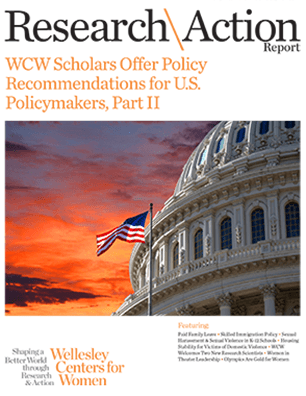Nan Stein, Ed.D., senior research scientist, Wellesley Centers for Women
Sexual Harassment and Violence Are Pervasive in K-12 Schools
Sexual harassment (SH) and sexual violence (SV) in schools are forms of sex discrimination and are prohibited under Federal Law Title IX. As SH/SV on college campuses consume a lot of attention and resources, so must such investments be directed toward prevention efforts in K-12 schools, where SH/SV are rampant and pervasive.
Concerning Data, Trends, and Experiences

Scientific national surveys of SH/ SV in U.S. schools have been undertaken since 1993. In the most recent one conducted in 2011, nearly half of 7th–12th grade students reported some form of sexual harassment in school (AAUW, 2011). In June 2015, the U.S. Department of Education (DOE) reported that there were 38 SH/SV cases under investigation by its Office for Civil Rights (OCR) at 37 elementary and secondary institutions while 16 months later, in October 2016, 110 SH/SV cases were under investigation at 100 elementary and secondary institutions. And litigation in the federal courts has not subsided. Clearly, SH/SV in schools remain tenacious.
Additionally, the definition of SH/SV used in the Indicators of School Crime and Safety Report (ISCSR), a joint effort by the Bureau of Justice Statistics (a part of the U.S. Department of Justice) and the National Center for Education Statistics (a part of DOE), does not conform to the definition of SH/SV as promulgated by the OCR of the DOE or by the U.S. Supreme Court in the Davis case (526 U.S. 629). Moreover, the category “serious violent victimization” in the ISCSR includes rape and sexual assault grouped together with robbery and aggravated assault, and “all violent victimization” includes serious violent crimes collectively with simple assault (NCVS, 2013). Instances of SH/SV in schools have become difficult to locate. The current way of categorizing the statistics ensures that SH/SV are impossible to determine (Stein, 2005). Not surprisingly, schools are investing precious resources of staff time and funds into a variety of products, services, and tools marketed to help schools address behaviors that interfere with safe and equitable learning environments. However, only a small percentage of approaches have ever been evaluated for effectiveness in preventing or addressing SH/SV. Not Alone: The First Report of the White House Task Force to Protect Students from Sexual Assault (2014) noted this problem when the Task Force conducted a systematic review of primary prevention strategies for reducing sexual violence. Out of 140 strategies reviewed by the Centers for Disease Control and Prevention (DeGue et al., 2014) for the Task Force, only two—Shifting Boundaries: Lessons on Relationships for Students in Middle School (Stein et al., 2010) and Safe Dates (Hazeldon 2004, 2010), both of which were designed and tested in K-12 schools—were identified as effective strategies with the greatest potential for reducing rates of SH/SV.
Approaches and RecommendationsDefinitions determine which data are collected. Federal agencies responsible for collecting data in schools should conform to one definition of SH/SV, as promulgated by the U.S. Department of Education (DOE) Office for Civil Rights and in 1999 by the U.S. Supreme Court in the Davis case.
- The Indicators of School Crime and Safety Report should include local and state data related specifically to SH/SV in schools, including frequency of occurrence. The data should be disaggregated so that gendered behaviors and crimes—such as rape and sexual assault—are distinguished from other forms of “serious violent victimization”—such as robbery and aggravated assault—in schools.
- States and cities/counties should be provided with gender, racial, ethnic, and linguistic data related to SH/SV prevalence in schools. Domestic and sexual violence advocates should be engaged in SH/SV prevention activities in collaboration with schools to address the specific needs of various communities.
- The DOE should recommend that schools evaluate the effectiveness of their prevention and intervention programs or implement only evidence-based and practice-informed approaches that specifically address SH/SV.
- School personnel should be trained by professionals who are knowledgeable of violence against women and gender violence to ensure that prevention policies and procedures are developed using proven methods and practices. Details of the policies, programs, and practices should be conveyed across the school community to ensure that staff, students, parents, and guardians are all informed and involved.
- In the 2014 Not Alone report, the DOE committed to collect and disseminate a list of Title IX coordinators from higher education institutions. Likewise, the DOE should require all K-12 schools to identify and submit to a central office, the name and contact information of the staff member who serves as coordinator of Title IX efforts. This information should be publicly available to assist educators, parents, students, and advocates inquiring about Title IX policies, procedures and practices in their schools. It would also enable the school coordinators to more easily reach out and share positive practices with one another, as was a hope for the post-secondary schools. Additionally, the DOE should regularly provide clarity of schools’ legal obligations to prevent, respond, and report cases of SH/SV swiftly and thoroughly.


